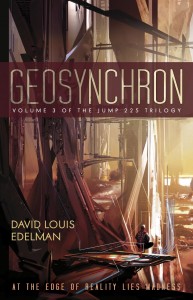William Gibson has said many times in interviews that he knew very little about computers when he wrote his groundbreaking, genre-spawning novel Neuromancer. And yet somehow, all the way back in 1984 he managed to not only anticipate things like Internet culture and wetware, but to understand them better than many of us do even today.
 Despite the fact that he’s now a best-selling — nay, legendary — author, I doubt that William Gibson knows much more about international crime and high-tech freelance spies than you or I do. And yet somehow, in his latest novel Spook Country, he manages to not only understand this world, but to extrapolate it and scope out its implications better than anyone else.
Despite the fact that he’s now a best-selling — nay, legendary — author, I doubt that William Gibson knows much more about international crime and high-tech freelance spies than you or I do. And yet somehow, in his latest novel Spook Country, he manages to not only understand this world, but to extrapolate it and scope out its implications better than anyone else.
Look at how effortlessly he explores a new medium called “locative art.” Locative art is what happens when you mash up GPS units and virtual reality. Think Second Life, if the whole thing was overlaid on top of the real world and accessible through 3D goggles.
The concept of locative art is cool enough. But Gibson’s genius isn’t that he can think up this cool new technology; it’s that he already knows how we’re going to use it. In the first chapter of Spook Country, a locative artist demonstrates the technology by showing a holograph of River Phoenix’s corpse lying face down on the sidewalk — in the exact place where River Phoenix’s corpse actually lay face down on the sidewalk.
Now that’s cool.
(At the risk of self-pimping, let me mention that this locative art technology has a lot of similarities to the multi network I mention in my own novels. Except in my books, the “multi projections” you see in the real world are the result of an imaginary nanotechnological system called the OCHRE network. In Gibson’s book, this is real. Indeed, he supposedly consulted with high-tech wizard Cory Doctorow on the details. You could head out to Radio Shack and build a Spook Country-style work of locative art with a laptop today. I wouldn’t be surprised if someone’s doing it right now.)
The story of Spook Country is really the same story that William Gibson has been telling in all his novels since Neuromancer. It’s remarkable how similar all these books are structured. Take a somewhat jaded young professional, and throw her in the middle of a struggle between mysterious powers way over her head. Sometimes these powers are hyper-intelligent AIs, sometimes they’re multinational corporations, sometimes they’re anonymous government agencies. The conflicts they engage in always involve lots of money being thrown around and the use of cutting-edge technology.
The three jaded POV characters in Spook Country are Hollis Henry, a former cult rock musician turned journalist; Tito, an operative in a boutique Cuban-Chinese crime family; and Milgrim, a junkie who’s been forcibly “recruited” to serve as the translator for a rather vicious CIA type named Brown. Our three protagonists become involved in a clandestine spy game going on between two unnamed freelance espionage forces. What exactly the game is Gibson doesn’t reveal until the book’s final pages, but it involves stolen iPods, geohacking, and a race to locate one very particular crate that’s floating on some ship somewhere in the world. (What’s in the crate? I won’t spoil it, and it doesn’t really matter that much anyway — but I will admit to feeling slightly let down by the revelation.)
In a way, Gibson’s vision of the world isn’t so much different from Philip K. Dick’s. Both envision a world of Little People being tossed around by enormous godlike forces. But while Dick’s characters are paranoid survivors just hanging on to the edge of sanity, Gibson’s have a certain groundedness and indomitable spirit. Hollis Henry and Henry Case and Cayce Pollard and Berry Rydell may not know exactly what game it is they’re playing, but through the course of a Gibson novel they learn how to hustle it. They may get buffeted around by the forces above, but in the end they’re rewarded for it.
Read more
 From my newsletter (because I really don’t have the time or energy these days to write anything original on my blog anymore):
From my newsletter (because I really don’t have the time or energy these days to write anything original on my blog anymore): Despite the fact that he’s now a best-selling — nay, legendary — author, I doubt that William Gibson knows much more about international crime and high-tech freelance spies than you or I do. And yet somehow, in his latest novel Spook Country, he manages to not only understand this world, but to extrapolate it and scope out its implications better than anyone else.
Despite the fact that he’s now a best-selling — nay, legendary — author, I doubt that William Gibson knows much more about international crime and high-tech freelance spies than you or I do. And yet somehow, in his latest novel Spook Country, he manages to not only understand this world, but to extrapolate it and scope out its implications better than anyone else.